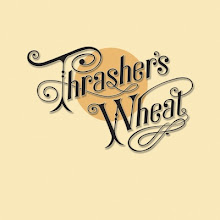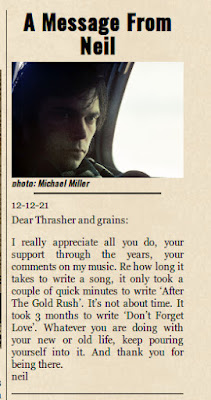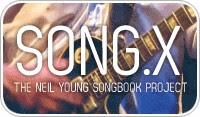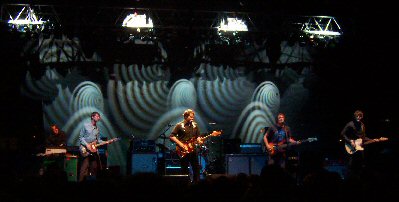Is "Down By The River" on Early Daze Album Really Take #1? + Comment of the Moment
Last month, the archival Early Daze album by Neil Young and Crazy Horse of ten early studio recordings was released and greeted "somewhat eagerly" by fans.
We say "somewhat eagerly" because our calling the release "non-essential" -- due to containing unreleased versions, alternative mixes, stereo mixes instead of mono -- was roundly pushed back on here in comments.
A new Neil Young with Crazy Horse album titled Early Daze, which is comprised of ten early studio recordings, will be released on June 28.
Turns out, there have been a few revelations with Early Daze release. Not the least of which is whether the classic jam "Down By The River" was really the very take of the song?
Our Comment of the Moment on REVIEWS: "Early Daze" Album by Neil Young and Crazy Horse by Ron:
I have been pondering the Down By The River 'is it really take one' question myself.
It does indeed sound like the EKTIN version apart from the vocals, but could they really have nailed that performance on 'take one'?. Perhaps, if it had previously been rehearsed, but we know how Neil usually likes to work. According to the recording dates on NYA both versions were recorded on the same day. Ultimately it doesn't really matter, it sounds great, but I remain curious - maybe I will pen a Letter To The Editor and ask Neil.
When Early Daze was first mentioned I mistakenly assumed it would include recordings that predated EKTIN, but apart from the versions of DBTR and Cinnamon Girl they were all in fact recorded post EKTIN. Maybe some of the other songs that appear on Early Daze were tried for EKTIN as well but weren't up to scratch at that time. I have been really enjoying listening to Early Daze though, great sound and performances. I also enjoy the studio banter and Neil's voice sounds so young!
I reread some of the passages in Shakey that relate to this period last night, and I was surprised to read about an apparently great version of Helpless that they played in the studio which was 'lost' because the recording engineer hadn't pressed the 'play' button. Is this version on 'Early Daze' the 'lost' version somehow now found, or a similar version or a completely different version?
Also I am very curious who is playing the electric guitar part on Helpless - is it Neil or Danny? The credits on NYA just say 'guitar' for both of them. To my ears the tone and sound of the electric guitar part sound unlike any other Neil performance I can think of, so maybe it's Danny?
I guess the point I was somewhat clumsily trying to make on DBTR take 1 or not was, regardless of how much rehearsing of it they had done (and I'm sure there would have been at least some), it seems to me quite remarkable to capture the fully formed performance of the the musical parts of the EKTIN released version on a first take. It's not one of Neil's simpler pieces either, so bravo to them!
Regarding Winterlong, Decade was a big part of my Neil Young journey, and although not one of my all time Neil favourites I have always enjoyed it. I always find it interesting to hear different versions of Neil's songs, acoustic versus electric, with Crazy Horse versus solo or with someone else, etc. The Early Daze version is a worthy addition in my opinion.
Many thanks to all the reviewers and comments - I have watched and read them all. Some great insights and observations - much appreciated.
Can't wait for Archives III !
Great question here Ron and many thanks for the CotM.
Maybe only Neil himself can clarify this? Could the Early Daze version of "Down By The River" simply be just the same take as Everybody Knows but a different mix of vocals? Or a different music take mixed with different vocal take?
Also, see:
- REVIEWS: "Early Daze" Album by Neil Young and Crazy Horse
- A Few Thoughts on Album Early Daze by Neil Young and Crazy Horse by Scotsman
- The Flying Scotzman just shared: "Early Daze #1: Look At All The Things"
- Early Daze #2: Winterlong
- Putting the Early Daze of Crazy Horse in perspective
- Early Daze: Neil Young with Crazy Horse Album Coming on June 28
Labels: @CrazyHorse4HoF, album, crazy horse, neil young, Neil Young and Crazy Horse, review

































 Human Highway
Human Highway

















 Concert Review of the Moment
Concert Review of the Moment





 This Land is My Land
This Land is My Land

 FREEDOM In A New Year
FREEDOM In A New Year









 *Thanks Neil!*
*Thanks Neil!*




![[EFC Blue Ribbon - Free Speech Online]](http://www.thrasherswheat.org/gifs/free-speech.gif)











 The Unbearable Lightness of Being Neil Young
The Unbearable Lightness of Being Neil Young Pardon My Heart
Pardon My Heart



 "We're The Ones
"We're The Ones  Thanks for Supporting Thrasher's Wheat!
Thanks for Supporting Thrasher's Wheat!




 This blog
This blog 
 (... he didn't kill himself either...)
#AaronDidntKillHimself
(... he didn't kill himself either...)
#AaronDidntKillHimself









































































 Neil Young's Moon Songs
Neil Young's Moon Songs




 Civic Duty Is Not Terrorism
Civic Duty Is Not Terrorism Orwell (and Grandpa) Was Right
Orwell (and Grandpa) Was Right


 What's So Funny About
What's So Funny About 



21 Comments:
This comment has been removed by the author.
I may do some comparing later, but the guitar interplay (Young+Whitten) sounds very much the same as EKtiN to me. I’d always imagined, based mainly on live recordings, the long solos aren’t played exactly the same way twice. Plus I made an inference from somewhat ambiguous wording on the website.
On the other hand, part of me doesn’t want to scrutinize or deconstruct in this way. I just love the raw softness of NY’s vocal on this version.
Shakey says all the vocals on the "Everybody Knows This Is Nowhere" album are overdubbed.
Later there is this quote,
—What did Briggs bring to Everybody Knows?
Neil - "Stability. The singing had to be coaxed outta me. Learning to sing live. Learning the need. Learning why to sing live. I was still overdubbing, because I wanted it to be really right—yet I was overdubbing. I didn’t know what I was doing wrong. Relearning the simplest basic thing—that music feels good—and should feel unified.""
And finally, there is this footnote,
"There’s an alternate version of “Down by the River”—same track, different background parts, different mix—with a very intense scratch vocal (done the night of the band recording) that hints at just what a challenge singing was to Young"
Those passages from Shakey are revealing. I only recalled NY discussing guitar overdubs on his first (self-titled) album. He didn’t like the process, so playing live with the band became his modus operandi. That lines up with this account: after developing a distaste for dubbing, NY spends much of the next album learning to record live.
Moreover, I get the impression he was quite self-conscious of his voice early on. You can hear it on some Buffalo Springfield tracks. And then there are the Decade liner notes for Burned. There was a learning curve. I can just picture producers and record execs pressuring him: “The songs are amazing Neil, but those vocals…” Dylan had already broken through at the time, but these guys take a while to learn. They like to play it safe. This accounts for Richie Furray singing a few of Neil’s Springfield songs.
“It ain’t a gold nugget; you can’t lay it plain.”
Early Daze is short and sweet, but a real treasure. It captures the essence of the time it was made, and it is definitely one of my favorite archival releases so far. I enjoy the innocence on display. Especially knowing how things evolved over the decades. Definitely one of those records you don’t want to end.
Peace 🙏
The recordings carry both simplicity and emotional depth. I don’t know if we (fans) can separate Early Daze from the context of the past 50 years, but when I listen to anything, I try to zero in on the immediate effect. How does it sound? How am I responding? Part of the innocence may be that these recordings weren’t done with an eye on posterity.
@Meta: I don’t believe we can un-hear 50 years of music, but when I listen to this record I can feel the times in which it was made. It has a quality that transports me back to that time and place. Of course those are my memories not theirs, so I suppose I’m just projecting my memories onto the music. Regardless; it does feel young to me, as if they’re still searching to find themselves musically. It’s not something that can be accurately replicated after the fact. It’s like a time capsule that has just been unearthed and it reveals itself as a reflection of a distant past.
Peace 🙏
One connection that was not evident to me until I was holding the Early Daze LP in my hands is the cover’s echo of Tonight’s The Night album art. The quality of the black and white photography with the black matte jacket instantly took me to that place. Here we have the band as they were before Whitten’s addiction took him away. Come On Baby Let’s Go Downtown still carries its mid-70s foreboding, but only because we know why the live version ended up on Tonight’s The Night. But in this unearthed studio version, the song is allowed to retain more of its rough charm, surrounded by others of its kind and pictures of the original band together as one.
A valiant effort , nice shot , too bad for the miss , plenty more yet to try
“The flash of a distant camera, reconnecting thoughts and actions… fragments of our missing dreams.” Album art/covers is one thing I’d like to do a deep dive on eventually. A lot could be said. One small point: many of NY’s covers are monochromatic or have muted colors. Per my understanding NY has some form of colorblindness. That makes a title like “Chrome Dreams” doubly interesting.
MR I love your idea. I want a large poster of the American Stars n' Bars cover art.
Abner, the Stars ‘n Bars cover is simultaneously well-crafted and absurdly crass. There’s an example of kitsch! I bet bars across the US would do brisk business, though, if they hung it behind the counter. The juxtaposition of pop art and debauchery is reinforced by the patriotic red and white, which are also the colors of Coke and Santa Claus.
I guess album covers, posters, etc. often veer toward the garish or outrageous since the idea is to grab attention. In a few ways, art gives the lie to consumerism and commodity culture. The “market” exchange value can be radically out of step with use value.
Convicted rapist pig Trump dodged one .... that inspires the jackals to the hunt .
This comment has been removed by the author.
American Stars N Bars seems to have two covers, the proper one bawdily representing Side 1 and its wink at “country rock” as a genre, and the alternate, more evocative cover for Side 2 with its collection of gems from sessions gone by. All the way down to the markered-up inner sleeve, Dean Stockwell did not hold back with his design for this record.
It’s also worth noting, taking a look at the covers for Early Daze and Tonight’s The Night, both were done by Gary Burden, with the contrasty quality of the matte black photography of the new album calling back to that of the classic, a precursor to the ditch. The difference in presentation is art vs artifact: Tonight’s The Night was built from those boozy SIR nights but includes a handful of tunes that combine into a more complex statement, which is reflected in its cryptic inner artwork as well as its starkly unsettling cover image.
Tonight’s The Night is about Danny Whitten, and Early Daze is just as much so. The cover image was repurposed from the little-seen back of the Wonderin’ bonus 7”. It shows him front and center, with its tracklisting going so far as to press the 45 RPM edition of Cinnamon Girl as a reminder of how serious Neil was at the time about keeping Danny increasingly up front. The album is a snapshot of an era, with the Burden/Heo/RTwerk & Co. assemblage of documentary photography reinforcing this concept. Other than its live counterpart from the Fillmore East, Early Daze is the only NYCH record to feature lead vocals by another singer. And it boasts three. Prior to these Archives releases Tonight’s The Night, with its throwback inclusion of the Fillmore “Downtown,” was the only Neil Young album to do this. Fifty years later, featuring Danny Whitten still holds importance.)
Great post on the album covers @tomatron. I hadn't looked at the Wonderin' 45 back cover before so thanks for identifying that. I also hadn't realised both Early Daze and TTN were done by Gary Burden.
It does feel to me that the main photos on Early Daze were selected to place Danny in the centre. Nice to see what I assume is David Briggs up in a balcony in the centrefold photo - took me a while to spot that!
@thrasher - I don't actually disagree with you that Early Daze is 'non-essential' overall, at least to the majority of Neil fans. I was disappointed myself when the track listing was first published. I have been surprised though, how much I have enjoyed listening to it since it was released. I am not sure I actually understand why either? It just seems to make me smile and want to sing along I guess. Most of the songs and arrangements are quite simple but to my ears they sound great. I love the overall sound, the playing, the guitar tone on Everybody's Alone and Helpless, Neil and Danny's voices and the harmonies. I even enjoy the between songs conversations. @Dan posted about the 'innocence' and 'how it feels young' and I would agree with this.
@Tomatron : Thank you so much for your overview of both album covers. Your insight is greatly appreciated. I’m pretty confident that the artwork for this archive release was meant to honor the memory of Danny, David, and Gary. All three were incredibly important to Neil’s career. It definitely feels like a loving tribute to all three men, and the music is as well.
It’s definitely one of my favorite archive releases so far. Mostly due to how it makes me feel while listening, as it reminds me of a more innocent time in my life when the weight of the world didn’t feel so heavy as it does now.
Peace 🙏
Dan, thanks for the acknowledgement/reminder of Gary Burden. Artists in such “supporting roles” don’t always get the deserved recognition.
Separately, I want to be clear that my comments on the Stars ‘n Bars cover weren’t meant to be hyper-critical or overstated… some of my favorite covers are designs others see as loud, busy, or too flamboyant. The sleeve for George Harrison’s Gone Troppo album is a good, relatively obscure instance: I think it fits that album and the colors really pop.
Comments are great! I very much like the grimy and debauched side of the cover art on Stars/Bars. I read an essay years ago on "my favorite album of all time" where someone chose stars/bars for its drunkenness. There was a feeling that drinking heavily was being celebrated in various ways and I too went through such a phase in my own life. I have absolutely no regrets for this phase and I can recall pulling my face off a sticky floor at 5 a.m. The point is we cannot stay there! All this circles back to addiction and a very serious set of issues. I did move on but several of my friends did not. One friend, who I saw recently on my travels, drinks 8-10 beers a day. This has basically killed him. Survival in this culture is not easy as so much of the substance abuse is tolerated or celebrated.
I have problems categorizing essential vs. inessential in a Neil context, or for any art. On a given day, it may feel “essential” for me to hear a certain song or not. And yes, part of this is that we use words with varying connotations. But it’s more than that. Essential to what, to whom? What is essence? A concept, yes, but that doesn’t tell us what the essence of a specific object or person is.
I’m probably overthinking… in some contexts, it’s better to use expected language.
You are not overthinking in my opinion. For this artist, what precisely is "essential" and how can we argue for it? Great questions.
Post a Comment
<< Home